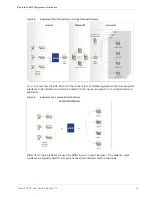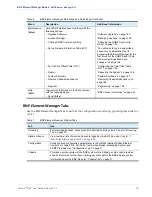
Selenio
TM
BNP User Guide, Release 3.7.1
21
Overview
- Redundancy
•
Missing program streams are identified by checking the PMT.
•
A missing video stream is detected.
You can assign a backup program for every program, and any program can be assigned to back up a
running primary program. The backup program can be another program on the same GigE port or it
can be on a different GigE port in the same chassis.
Program-level redundancy is supported such that when there is a groomed program missing, a
designated input program can function as a standby program and will take over for the missing
program. The detection of a PAT / PMT missing for over 2 seconds is used as the threshold for the
detection of the missing input program.
A program in an input TS that has SSM redundancy configured cannot be used as a backup program
for program redundancy.
For information about Program Redundancy configuration, see “Program Redundancy” on page 152.
Port Redundancy
The BNP supports Gigabit Ethernet port output mirroring within the same chassis. The mirrored port
serves as a standby port in case the primary port fails. The mirroring port must have a unique
IP address configured. The BNP delivers identical streams to both the primary port and the mirrored
port with the same destination IP address and port number, but a different source IP address.
The multiplexes output on one GigE are delivered to the mirrored GigE port simultaneously as a fully
operational, redundant output GigE port. Regardless of mirroring, all active GigE ports must have
unique IP addresses assigned.
To set GigE port-level redundancy, see “GigE Port Configuration” on page 44.
1:1 Chassis-level Redundancy
When the ports and global settings are configured to do so, the BNP provides 1:1 redundancy. The BNP
supports hot-standby 1:1 chassis redundancy through heartbeat and virtual IP failover mechanisms.
Heartbeats provide the ability to synchronize failover to a secondary BNP. A heartbeat daemon on the
primary unit will send out unicast heartbeat messages every 250 milliseconds.The heartbeat daemon
running on the standby BNP listens to the heartbeats coming from the primary BNP. If the standby BNP
does not hear the primary BNP’s, it initiates a failover and takes ownership. The heartbeat daemon
running on the standby BNP checks for heartbeats coming from the primary BNP over both the normal
Ethernet 10/100BaseT management connection and optionally the eighth Gigabit Ethernet port (GigE
8) connection (when used as a backup to the Ethernet 10/100BaseT management port).
The Backup LED on the front of the chassis indicates the redundancy role of a chassis: green indicates
the active chassis, and orange indicates a standby chassis.
The standby chassis takes over if the primary (active) chassis fails, if there is a system or module
overheat, failed fan, failed power supply, or missing heartbeat from the primary unit. The former
standby (now the active) chassis now becomes configurable through the BNP
Element Manager
.
















































